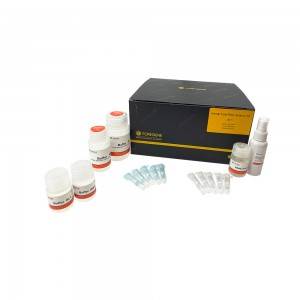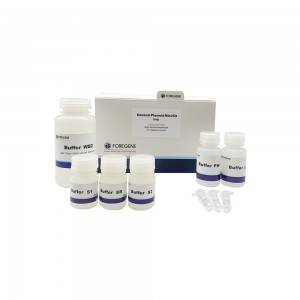Foreasy HS Taq DNA Polymerase
Description
Foreasy HS Taq DNA Polymerase is a new Taq enzyme expressed in Escherichia coli engineering bacteria by gene recombination technology . After the enzyme is treated with a special process, it's activity is inhibited before thermal activation, thereby inhibiting the non-specific amplification caused by the non-specific annealing of primers or primer dimers under low temperature conditions. This product is suitable for highly specific PCR Reaction, M ultiple x PCR , high GC content ( > 60% ) ,with secondary structure or other strong background genomics amplification and large-scale genomics amplification detection. The enzyme has 5' → 3' DNA polymerase activity and 5' → 3' exonuclease activity, but no 3' → 5' exonuclease activity.
Kit components
| Component | IM-01021 | IM-01022 | IM-01023 |
| Foreasy HS Taq DNA Polymerase (5 U/μL) | 5000 U (1 mL) | 50 KU (10 mL) | 500 KU (100 mL) |
| 2× Taq Reaction Buffer | 25mL ×5 | 250 mL ×5 | 500 mL × 25 |
Features&advantages
- High specificity: The enzyme with high hot-start activity.
- Fast Amplification: 10 sec/kb.
- High template adaptability : can be used to efficiently amplify High GC value and various difficult-to-amplify DNA template.
- Strong fidelity: The fidelity is 6 times of ordinary Taq Enzyme.
Kit application
- Various PCR/qPCR System and direct PCR system
- PCR Amplified DNA Fragment
- DNA mark
- DNA Sequencing
- PCR plus A tail
Activity Definition
1U : The amount of enzyme required to incorporate 10 nmol of DNA into acid-insoluble matter using activated salmon sperm DNA as template / primer, 74 °C, 30 minutes.
Reaction Condition
| Temperature | Reaction Time | Cycle time |
| 37°C | 5 min | 1 |
| 94°C | 5 min | 1 |
| 94°C | 10 Secs | 40 |
| 60°C | 10 Secs |
Note: For 10 µL and 20 µL systems, add an equal volume of mineral oil if the thermal cycler does not have a heat lid .
PCR reaction conditions vary depending on the structural conditions of templates, primers, and the like. In the specific operation, it is necessary to design the optimal reaction conditions, including annealing temperature, extension time, etc., according to the specific conditions such as the template type, the size of the target fragment, the base sequence of the amplified fragment, and the GC content and length of the primer.
Storage
-20 ± 5 °C for 2 years or at -80 °C for long-term storage.
No amplification signals
1.The Taq DNA Polymerase in the kit loses its activity due to improper storage or expiration of the kit.
Recommendation: Confirm the storage conditions of the kit; re-add an appropriate amount of Taq DNA Polymerase to the PCR system or purchase a new Real Time PCR Kit for related experiments.
2.There are a lot of inhibitors of Taq DNA Polymerase in the DNA template.
Suggestion: Repurify the template or reduce the amount of template used.
3.The Mg2+ concentration is not suitable.
Recommendation: The Mg2+ concentration of the2× Real PCR Mix we provide is 3.5mM. However, for some special primers and templates, the Mg2+ concentration may be higher. Therefore, you can directly add MgCl2 to optimize the Mg2+ concentration. It is recommended to increase the Mg2+ 0.5mM each time for optimization.
4.The PCR amplification conditions are not suitable, and the primer sequence or concentration is improper.
Suggestion: confirm the correctness of the primer sequence and the primer has not been degraded; if the amplification signal is not good, try to lower the annealing temperature and adjust the primer concentration appropriately.
5.The amount of template is too little or too much.
Recommendation: Perform template linearization gradient dilution, and select the template concentration with the best PCR effect for Real Time PCR experiment.
NTC has too high fluorescence value
1.Reagent contamination caused during operation.
Recommendation: Replace with new reagents for Real Time PCR experiments.
2.Contamination occurred during the preparation of the PCR reaction system.
Recommendation: Take necessary protective measures during operation, such as: wearing latex gloves, using a pipette tip with a filter, etc.
3.The primers are degraded, and the degradation of the primers will cause non-specific amplification.
Suggestion: Use SDS-PAGE electrophoresis to detect whether the primers are degraded, and replace them with new primers for Real Time PCR experiments.
Primer dimer or non-specific amplification
1.The Mg2+ concentration is not suitable.
Recommendation: The Mg2+ concentration of the 2× Real PCR EasyTM Mix we provide is 3.5 mM. However, for some special primers and templates, the Mg2+ concentration may be higher. Therefore, you can directly add MgCl2 to optimize the Mg2+ concentration. It is recommended to increase the Mg2+ 0.5mM each time for optimization.
2.The PCR annealing temperature is too low.
Suggestion: Increase the PCR annealing temperature by 1℃ or 2℃ each time.
3.The PCR product is too long.
Recommendation: The length of the Real Time PCR product should be between 100-150bp, not more than 500bp.
4.The primers are degraded, and the degradation of the primers will lead to the appearance of specific amplification.
Suggestion: Use SDS-PAGE electrophoresis to detect whether the primers are degraded, and replace them with new primers for Real Time PCR experiments.
5.The PCR system is improper, or the system is too small.
Suggestion: The PCR reaction system is too small will cause the detection accuracy to decrease. It is best to use the reaction system recommended by the quantitative PCR instrument to re-run the Real Time PCR experiment.
Poor repeatability of quantitative values
1.The instrument is malfunctioning.
Suggestion: There may be errors between each PCR hole of the instrument, resulting in poor reproducibility during temperature management or detection. Please check according to the instructions of the corresponding instrument.
2.The sample purity is not good.
Recommendation: Impure samples will lead to poor reproducibility of the experiment, which includes the purity of the template and primers. It is best to repurify the template, and the primers are best purified by SDS-PAGE.
3.The PCR system preparation and storage time is too long.
Suggestion: Use the Real Time PCR system for PCR experiment immediately after preparation, and don’t leave it aside for too long.
4.The PCR amplification conditions are not suitable, and the primer sequence or concentration is improper.
Suggestion: confirm the correctness of the primer sequence and the primer has not been degraded; if the amplification signal is not good, try to lower the annealing temperature and adjust the primer concentration appropriately.
5.The PCR system is improper, or the system is too small.
Suggestion: The PCR reaction system is too small will cause the detection accuracy to decrease. It is best to use the reaction system recommended by the quantitative PCR instrument to re-run the Real Time PCR experiment.

















